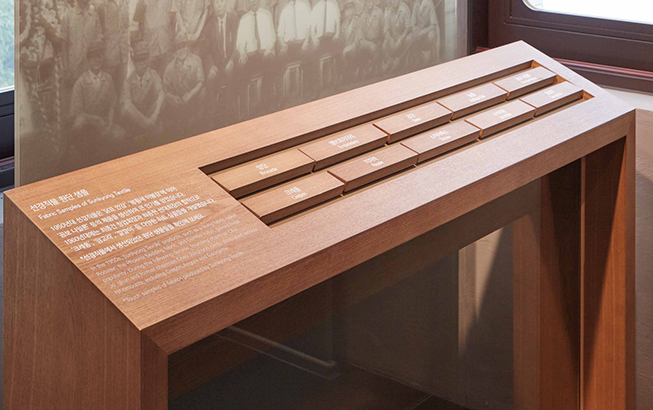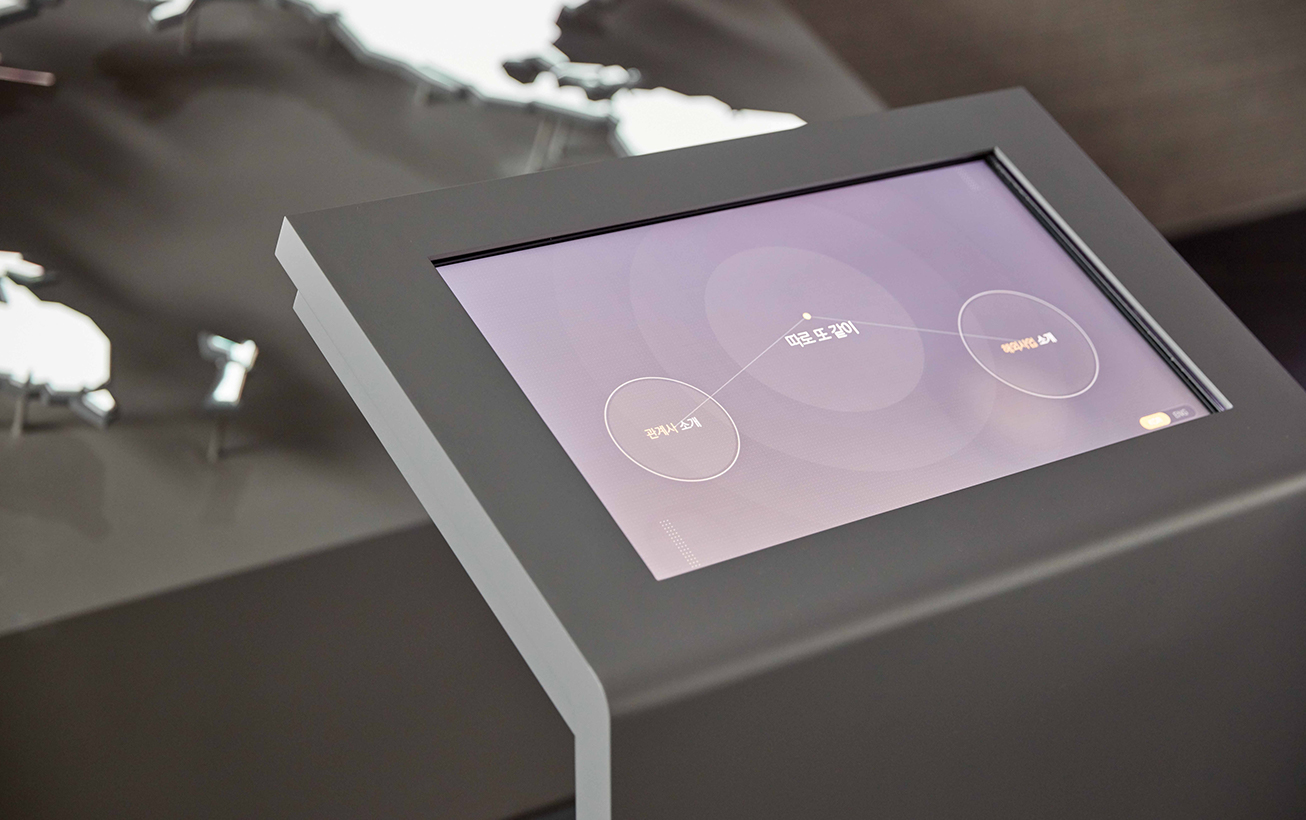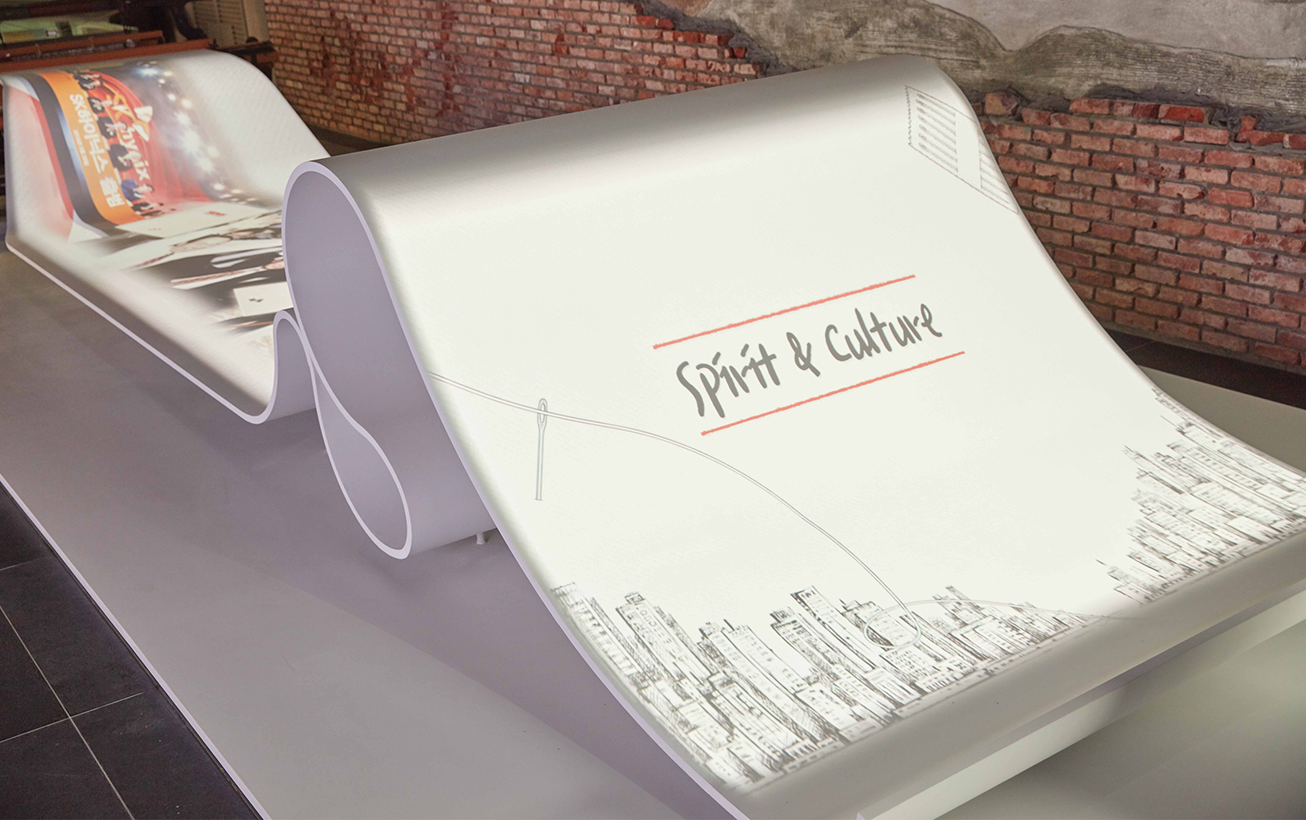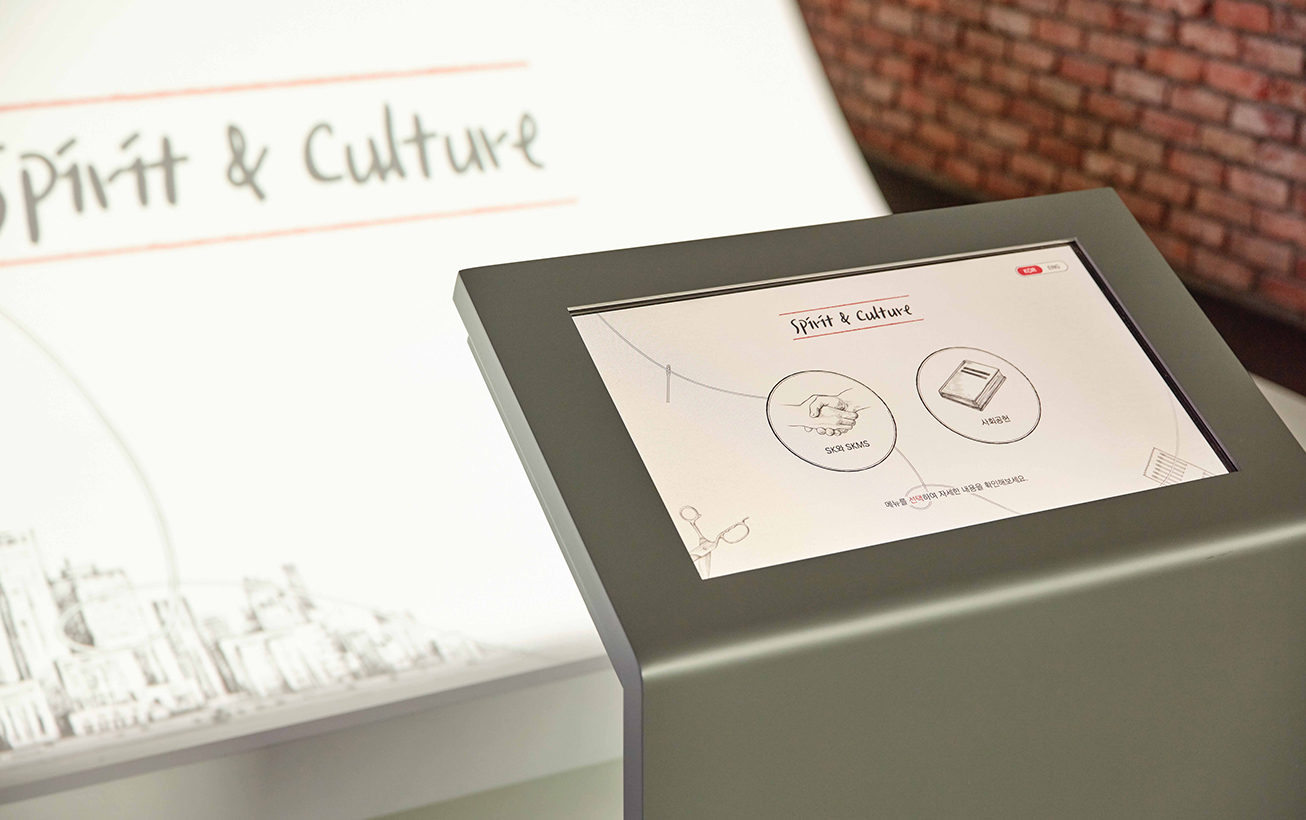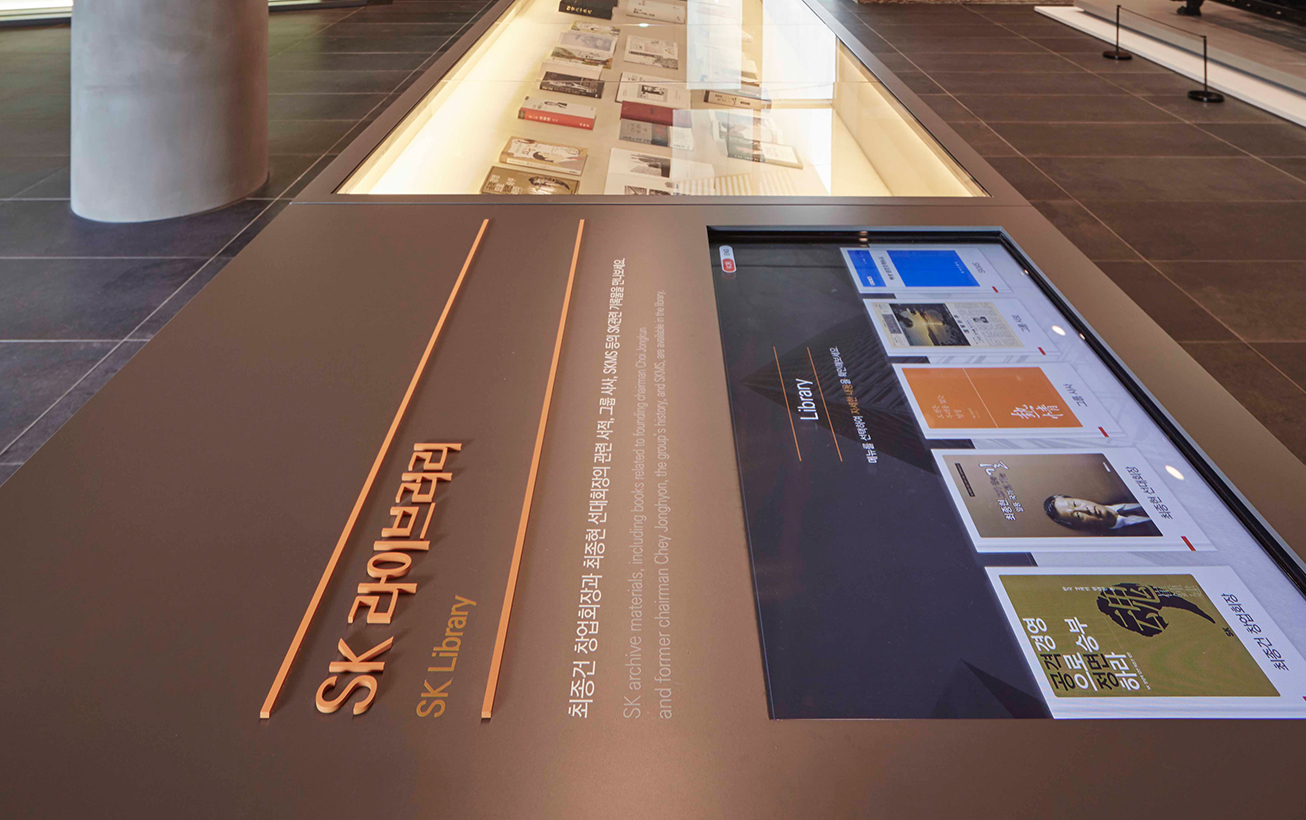Where it begins...
The first floor space recreates Sunkyong Textiles, which was the forerunner to SK, at the exact moment of incorporation. (1F)
In 1953 the Suwon textiles factory had been destroyed in the Korean War and Founding Chairman Choi Jongkun felt bad about how the dreams of the ruined factory employees had been crushed and so he acquired the factory. He searched for parts in the rubble of the factory and salvaged what he could to get some looms up and running. These looms, which wove thread into hope, were the start of Sunkyong Textiles, the forerunner of SK. On the 1st floor, the “Moment of Founding” exhibit displays two looms, a model of an automatic loom and a model of the Founding Chairman fixing a loom as well as models of factory workers.
The early days and building the base for growth
The second floor space introduces the formative years from 1953-1973 when expansion and diversification provided the basis for SK’s growth. (2F)
As a result of the Korean War, 1950s Korea was the poorest country in the world. On this land where there had been only darkness, words like ‘hope’ and ‘start’, which hitherto and been inappropriate, began to be used here and there. At this time, SK Group started as Sunkyong Textiles, a small, ruined textiles factory. Due to the war, there was neither an upright building nor a functioning loom. Despite this, Founding Chairman Choi Jongkun spoke about ‘hope’ and ‘beginning’ to the assembled workers of the factory and under his leadership they worked together to overcome adversity. Thereafter, in the 1970s, Sunkyong became the first fabric business group and with paegi and passion and made the first great leap forward. On the second floor, the < early days and building the base for growth > exhibit introduces key moments from the group’s history from 1953 to 1973 in the form of dioramas, video contents, a media wall and graphic displays. Here you can also see actual fabrics produced by Sunkyong Textiles at the time as well as a recreation of the Chairman’s Office.
Becoming the heartbeat of the Korean Economy through Energy and Chemicals
This part of the basement introduces the history of the company as it drove the Korean economy forward from 1974 to 1991 by setting ambitious targets and accomplishing them. (B1)
In November 1973, Founding Chairman Choi Jongkun passed away and the mantle passed to Former Chairman Chey Jong-hyon. In 1976, Former Chairman Chey set up a general trading company and turned his focus on the export market. Additionally, through the development of polyester film, Sunkyong also gained renown in the chemical industry. Later, the establishment of Sunkyong Construction and the acquisition of Korea National Oil led to expansion in those businesses. However, the company has not rested on its laurels. In order to turn Korea, which is bereft of natural resources, into an oil-producing country, the company sought to develop overseas oilfields. Besides that, the company has also entered various other fields of business such as biotechnology, thus leading Sunkyong to become a major axis of the Korean economy and a company that fears neither challenge nor change. Finally, the commencement of operations at all the factories at the CLX Ulsan site in 1991 marked the completion of the company’s efforts to achieve vertical integration from oil to textiles. The exhibit displays the history of the group from 1974 to 1991 via touchscreens, graphic panels, clear displays and models.
Paving the way for an ICT-based society
This part of the basement introduces the period from 1992 to 1998 as the company prepared for the 21st century. (B1)
From 1992 until the death of Former Chairman Chey Jong-hyon in 1998, Sunkyong Group pursued a strategy of business diversification in order to enhance its existing energy and chemicals businesses. Additionally, the company also entered the telecommunications business with the acquisition of Korea Mobile Telecommunications Corp. However, the company did not restrict itself to the local market, but became the first Korean company to open an office in Beijing and started preparing to spread out around the world, as befits a group operating in the global era of the 21st century. As part of this, the company adopted a new corporate image changing from Sunkyong Group to SK Group, a transformation that inspired the image of a company on the up while opening the door to a new era. This was the moment when the group’s values and potential combined with SK’s long history of growth based on change and innovation to create a bright new future. The < Paving the way for an ICT-based society> exhibit introduces the group’s history during that period using touchscreens, panels and sliding vision boards.
With unyielding resolve and passion
This section of the basement introduces Founding Chairman Choi Jongkun and Former Chairman Chey Jong-hyon’s legacy in the form of their entrepreneurship and their managerial mindset. (B1)
Just as Rome was not built in a day, so it took time for Sunkyong to develop into SK. Founding Chairman Choi Jongkun took the seeds of his dream for an integrated cotton plant and sowed them on the war-torn land. Thereafter, Former Chairman Chey Jong-hyon and all SK members nurtured the shoots that grew from those seeds and cultivated them into mighty trees. He had a vision and prepared for it more than anyone. It was not always plain sailing. However, every time we faced a setback, SK used its limitless paegi and passion to break through and overcome each crisis. With an eye to the future, we looked at each crisis as an opportunity to challenge ourselves and thus made SK what it is today. SK has nurtured talent for the society of tomorrow and for the future of the country and has forged a path for all members of society to live a happy and fruitful life. SK has long dreamed of creating a happy society, and now, the concern and effort that we made in order to do that has come to fruition and the benefits unfold in front of us. In the < With unyielding resolve and passion> exhibit, visitors can turn the dial to find out more detail about the historic items contained on the RFID cards.
Separately but together
This area of the basement introduces SK Group’s affiliates and businesses. (B1)
From the perspective of ‘separately’, each of SK’s affiliates must develop the capability to deal with its own business environment and the unique characteristics of its business model. However, each affiliate must also work ‘together’ to find ways to enhance synergy to create stability and growth. Through the touch monitor and the mapping video, visitors can get information about SK’s key affiliates and their business, and the group’s current overseas business.
Spirit & Culture
This exhibit in the basement displays SK’s core values and corporate culture in the form of looms and cotton fabric. (B1)
`
Just as the warp and the weft are woven in the loom to create a finished fabric, in the ‘Spirit and Culture’ section, visitors can see the motif of a loom and fabric showing how SK’s key values and corporate culture have combined over the past 66 years to make a brighter future filled with potential. On the display, which is shaped like a bolt of fabric, a video is projected showing the key parts of SKMS and our contributions to society and the front wall has been constructed to symbolize ‘paegi’ using bricks, tiles and roof tiles reclaimed from the Sunkyong Textiles Factory in Suwon.
SK Library
This library in the basement shows real media contents from SK’s history and also has searchable digital contents to view. (B1)
In the SK Library, visitors can see books about Founding Chairman Choi Jongkun, Former Chairman Chey Jong-hyon, the history of the group, SKMS, which drives its core philosophy and corporate culture, as well as copies of the company magazine. Also, related publications have been collated in a digital database in which detailed information can be searched and read.








